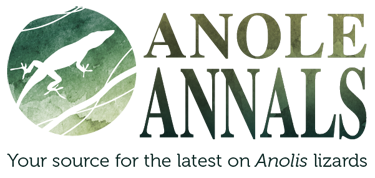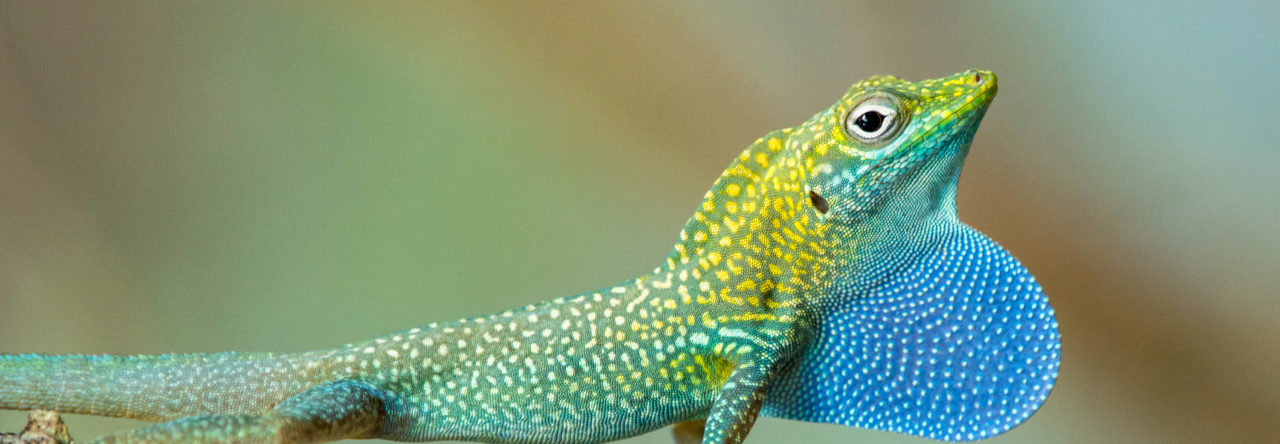While exploring the grounds of Fairchild Tropical Botanical Gardens with Janson Jones this past weekend, we extremely fortunately happened upon a large adult male Cuban knight anole (A. equestris) in full displaying swing. Despite the fact that knight anoles have an impressively large dewlap, I have often found this to be a relatively rare event, as large crown-giant species tend to display less than other smaller and more active species. This individual was displaying at a height of ~15 m, just below the fronds of a large Royal Palm (Roystonea regia). We didn’t see any other neighboring knight anoles, so were unsure if this was a directed or passive display series. In all, this lizard performed perhaps 4-5 sets of dewlap displays (each comprising of 4-5 dewlap extensions) before stopping and retreating back into the canopy.
Anoles typically follow a predictable and repeated pattern of display that gradually increases in intensity. Initially, and rather lethargically, an individual will nonchalantly raise its head and extend its dewlap without much extra effort (stage a); described below from Losos (2009).

Adapted from Losos (2009), which itself is adapted from Losos (1985). Aggressive behavior of A. marconoi showing three stages of increasing display intensity – note stage (c) include full body elevation alongside simultaneous tail and dewlap extensions.
This then escalates to include a slight body raise (stage b).
And ultimately results in a dramatic finale – in full display all limbs will be extended to raise both their body from the substrate (in this case the trunk of a palm tree) and elevate their tail (stage c). In the following picture you can see this final stage of displaying where intensity peaks – albeit in this individual with a regenerated (and rather stubby) tail.
And then the display starts to wind back down.
Using A. equestris collected from Miami, Enrique Font published a couple of classic papers in the late 80s/early 90s describing the functional morphology (pdf here) and display patterns (pdf here) of dewlap extensions in A. equestris. Specifically, Font & Kramer (1989) identified five distinct display patterns of A. equestris (see below). A couple of hypotheses exist for why a species may display a wide diversity of display patterns; for example, i) a diverse repertoire may facilitate visual communication between individuals spaced apart at varying distances (Hover & Jenssen 1976), or alternatively, ii) this diverse repertoire may faciliate non-physical resolution of agonistic interactions and therefore minimize the possibility of any escalation resulting in physical harm (Jenssen 1977).
![From Font & Kramer (1989). Cartoon representations of the five display types [of A. equestris]; unit durations are scaled by the sample means. The scale bar is in seconds. Dotted bobs may or may not be present at the end of the display. Unit 3 of display type C had either one or two bobs.](https://i0.wp.com/www.anoleannals.org/wp-content/uploads/2016/06/Font-Kramer_Fig-2.png?resize=629%2C538&ssl=1)
From Font & Kramer (1989). Cartoon representations of the five display types [of A. equestris]; unit durations are scaled by the sample means. The scale bar is in seconds. Dotted bobs may or may not be present at the end of the display. Unit 3 of display type C had either one or two bobs.
…before continuing into another display set.
This sideways head-swaying is described in detail by Front & Kramer (1989) as their display type A2 (see Fig above). In a follow-up paper, Font & Rome (1990) described the independent hyoid muscles associated with the different aspects of A. equestris display (i.e., vertical head-bobbing and lateral head-swaying).

Adapted from Font & Rome (1990). Video recordings of displaying A. equestris were synchronized with electromyographic (EMG) recordings of two hyoid muscles (M. certaohyoideus and M. omohyoideus) used during visual displays. Upper graph depicts vertical head movement (ie. amplitude of headbobs) through time, including the side-to-side movement of the head at the end of the display (display type A2 from Font & Kramer 1989, and observed in this photo series). Blackened block represents dewlap extension through time.
Has anyone else observed this lateral head-swaying concluding dewlap displays in A. equestris? (And, if possible, has anyone managed to capture it on video?)
Check out Janson’s website (phosTracks), for some great photographs of a wide range of Floridian wildlife (including anoles!).
Some refs
– Font, E, Kramer, M. 1989. A multivariate clustering approach to display repertoire analysis: headbobbing in Anolis equestris. Amphibia-Reptilia. 10(3): 331-344
– Font, E, Rome, LC. 1990. Functional morphology of dewlap extension in the lizard Anolis equestris (Iguanidae). Journal of Morphology. 206(2): 245-258
– Hover, EL, Jenssen, TA. 1976. Descriptive analysis and social correlates of agonistic displays of Anolis limifrons (Sauria, Iguanidae). Behaviour. 58: 173-191.
– Jenssen, TA. 1977. Evolution of anoline lizard display behavior. Amer. Zool. 17: 203-215.
– Losos, JB. 1985. Male aggressive behavior in a pair of sympatric sibling species. Breviora. 484: 1-30
– Losos, JB. 2009. Lizards in an evolutionary tree: ecology and adaptive radiation of anoles. Univ. of California Press.
- Do Bigger Anoles Have More Diverse Parasites? Not in Brazilian Anolis fuscoauratus - May 28, 2020
- What Role Do Chemicals Play in Anole Social Interactions? - May 27, 2020
- Hurricane-blown Anoles are a NY Times Cartoon! - May 20, 2020


















Trevor
Here’s a CKA doing the head sway which I’ve seen described as a figure 8.
https://gtgracing-my.sharepoint.com/:v:/p/trev/EbHwITAyBiVNgDViIAT0i3EB4cag3w27EAfE2srUrqwJEQ?e=w8XD8I
James Stroud
Great video!!